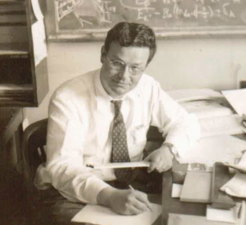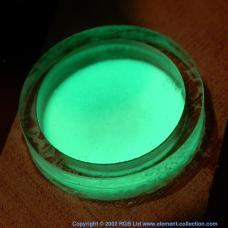Promethium
Promethium is a chemical element with the symbol Pm and atomic number 61. It is a rare and radioactive lanthanide, which is part of the periodic table's f-block. Promethium is notable for being the only lanthanide and one of the few elements that have no stable isotopes. All its isotopes are radioactive, and it is one of the two such elements that can be found in nature, the other being technetium. The most common isotopes of promethium are promethium-145, promethium-146, and promethium-147, with promethium-147 being the most abundant and widely used.
Properties[edit | edit source]
Promethium is a soft, silvery, metallic element that exhibits luminescence, emitting a pale blue or greenish glow in the dark when exposed to oxygen. This property makes it useful in certain types of radioluminescent materials. It has chemical properties typical of the lanthanides, forming trivalent ions (Pm^3+) that are usually colorless in solution.
Occurrence[edit | edit source]
Promethium is extremely rare in nature. It is found in trace amounts in the Earth's crust, primarily as a product of uranium decay and in some minerals that contain other rare earth elements. The element is more commonly obtained through nuclear reactors, where it is produced as a byproduct in the fission of uranium fuel.
Applications[edit | edit source]
Promethium's most significant application is in the production of batteries for use in space satellites and military equipment, where its radioactive decay provides a steady heat source that can be converted into electrical energy. These batteries, known as radioisotope thermoelectric generators (RTGs), can provide power for long durations, making them ideal for missions where solar power is not feasible. Promethium is also used in the manufacture of luminous paint, although this use has declined due to safety concerns associated with its radioactivity.
Health and Safety[edit | edit source]
As a radioactive element, promethium poses health risks if not handled properly. It can emit beta particles that are harmful to human tissue and can increase the risk of cancer upon prolonged exposure. Safety protocols involve shielding and strict regulatory controls to minimize exposure to promethium during its handling and transport.
History[edit | edit source]
Promethium was first identified in 1945 by Jacob A. Marinsky, Lawrence E. Glendenin, and Charles D. Coryell during their research on the fission products of uranium. The element was named after Prometheus, the Titan from Greek mythology who stole fire from the gods and gave it to humanity, symbolizing the use of promethium in providing energy.
Isotopes[edit | edit source]
All isotopes of promethium are radioactive. Promethium-147, with a half-life of about 2.62 years, is the most stable isotope. It decays into stable samarium-143 through beta decay. The radioactivity of promethium isotopes limits their use to applications where their radioactive properties can be beneficially employed.
See Also[edit | edit source]
![]()
This chemical element related article is a stub. You can help WikiMD by expanding it.
Search WikiMD
Ad.Tired of being Overweight? Try W8MD's physician weight loss program.
Semaglutide (Ozempic / Wegovy and Tirzepatide (Mounjaro / Zepbound) available.
Advertise on WikiMD
|
WikiMD's Wellness Encyclopedia |
| Let Food Be Thy Medicine Medicine Thy Food - Hippocrates |
Translate this page: - East Asian
中文,
日本,
한국어,
South Asian
हिन्दी,
தமிழ்,
తెలుగు,
Urdu,
ಕನ್ನಡ,
Southeast Asian
Indonesian,
Vietnamese,
Thai,
မြန်မာဘာသာ,
বাংলা
European
español,
Deutsch,
français,
Greek,
português do Brasil,
polski,
română,
русский,
Nederlands,
norsk,
svenska,
suomi,
Italian
Middle Eastern & African
عربى,
Turkish,
Persian,
Hebrew,
Afrikaans,
isiZulu,
Kiswahili,
Other
Bulgarian,
Hungarian,
Czech,
Swedish,
മലയാളം,
मराठी,
ਪੰਜਾਬੀ,
ગુજરાતી,
Portuguese,
Ukrainian
Medical Disclaimer: WikiMD is not a substitute for professional medical advice. The information on WikiMD is provided as an information resource only, may be incorrect, outdated or misleading, and is not to be used or relied on for any diagnostic or treatment purposes. Please consult your health care provider before making any healthcare decisions or for guidance about a specific medical condition. WikiMD expressly disclaims responsibility, and shall have no liability, for any damages, loss, injury, or liability whatsoever suffered as a result of your reliance on the information contained in this site. By visiting this site you agree to the foregoing terms and conditions, which may from time to time be changed or supplemented by WikiMD. If you do not agree to the foregoing terms and conditions, you should not enter or use this site. See full disclaimer.
Credits:Most images are courtesy of Wikimedia commons, and templates, categories Wikipedia, licensed under CC BY SA or similar.
Contributors: Prab R. Tumpati, MD






